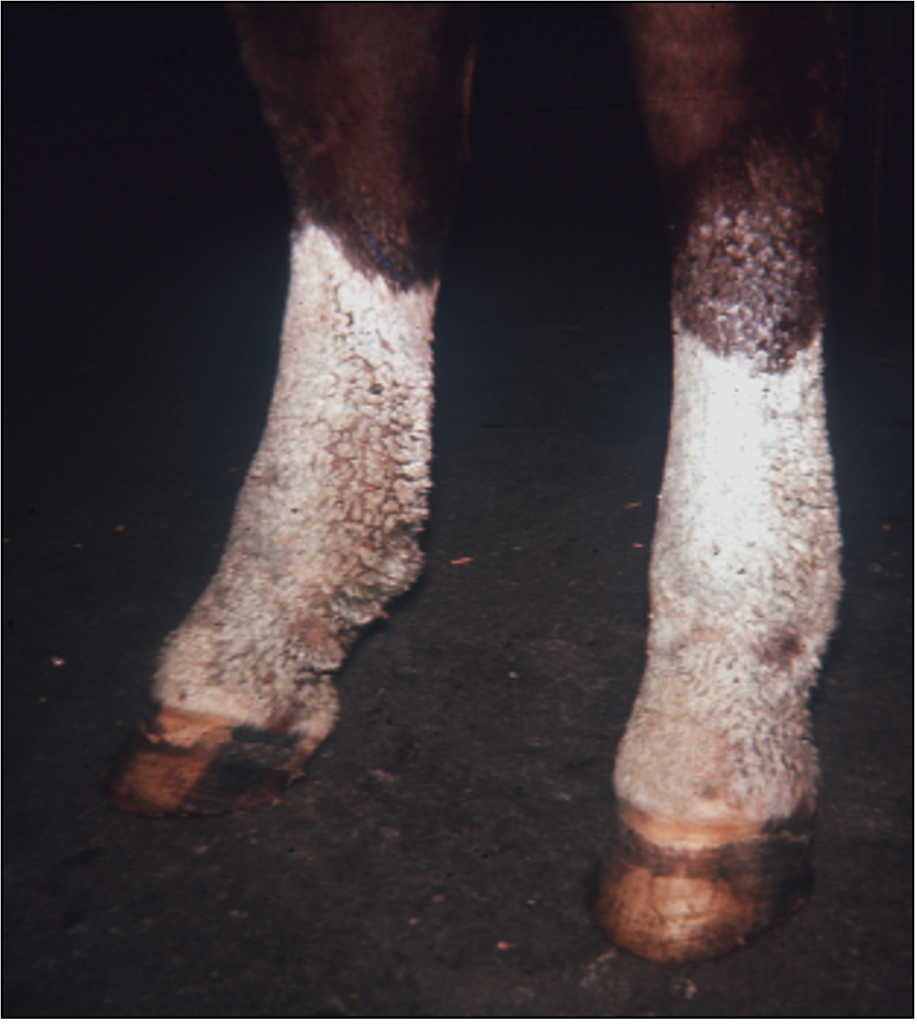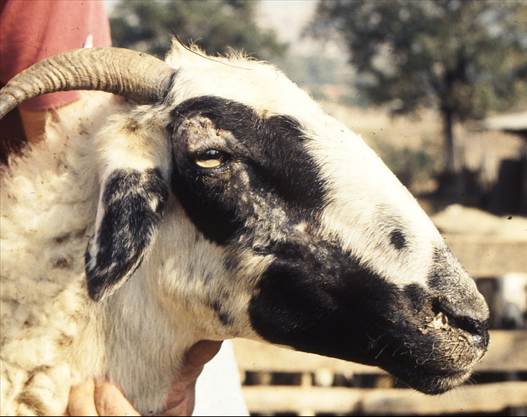1.3 Folliculitis and Furunculosis – Large Animals
Learning Objectives
- What bacteria typically cause folliculitis and furunculosis in horses, goats and sheep?
- What is the main predisposing factor?
- Describe the clinical syndromes in horses, goats and sheep.
- What test can you easily perform in practice to support your clinical diagnosis of bacterial folliculitis and furunculosis?
- How do you manage bacterial folliculitis and furunculosis?
-
General Considerations
- Staphylococcus folliculitis and furunculosis are common in horses, goats and sheep.
- Folliculitis is characterized by follicular papules, pustules and crusts. Chronic and healing stages are often characterized by circular lesions of alopecia and scaling – “classic” ringworm lesions!
- In furunculosis the hair follicle ruptures and the inflammatory process extends to the surrounding dermis and subcutaneous tissue. This stage is characterized by various combinations of nodules, draining tracts, ulcers and crusts.
-
Etiology and Pathogenesis
- Causative agents are typically Staphylococcus species with Staphylococcus aureus being a common cause of infection.
- It is usually secondary to an underlying primary disease or a predisposing factor such as trauma.
-
Clinical Syndromes
- In horses, three main syndromes are described:
- Truncal folliculitis and furunculosis (heat rash, saddle rash).
- Pastern folliculitis.
- Tail pyoderma.
- Truncal folliculitis and furunculosis:
- No age, sex or breed predilection.
- It is common.
- Corynebacterium pseudotuberculosis is a rare cause of this condition.
- A painful papulonodular eruption that starts in the saddle and tack areas, but can spread.
- Most cases are seen in spring and summer.
- Differential diagnoses include dermatophytosis, dermatophilosis, or corynebacterial folliculitis.
- Pastern folliculitis:
- No age, sex or breed predilection.
- It is less common.
- The causative agent is usually Staphylococcus aureus or B-hemolytic Streptococcus.
- Crusted papules and pustules are formed around the posterior aspect of the pastern and fetlock but can spread to other pastern regions. One or more limb can be involved.

This horse has pastern dermatitis complicated with staphylococcal folliculitis. Note the crusts adhered to groups of hair shafts giving the coat a wet appearance. -
- If left untreated, the lesions coalesce and may produce large areas of ulceration and suppuration.
- It is occasionally pruritic.
- Pastern folliculitis should be differentiated from other causes of pastern dermatitis, especially allergic contact dermatitis, contact photosensitization, dermatophytosis, dermatophilosis, and pastern vasculitis.
- Tail pyoderma:
- No age, sex or breed predilection.
- It is a rare disease.
- The causative agent is typically Staphylococcus spp.
- Folliculitis and furunculosis may develop secondary to tail rubbing.
- In horses, three main syndromes are described:

-
-
-
- Underlying causes of tail rubbing should be sought and treated in conjunction with treatment for the bacterial infection (pinworms, mange, lice, insect bite hypersensitivity, food allergy, and stable vice).
-
- In goats, staphylococcal folliculitis and furunculosis are considered common and, as for other species, are typically secondary to a primary disease or factor.
- Various coagulase-positive and -negative staphylococcal species have been associated with folliculitis in goats. Common ones include Staphylococcus aureus, Staphylococcus chromogenes, and Staphylococcus hyicus.
- No age, breed or sex predilection is reported.
- Predisposing factors to consider include trauma, stress of parturition, high humidity and moist environments.
- Examples of predisposing diseases include chorioptic mange, parapoxvirus infection (orf) and zinc-responsive disorder.
- Lesions (papules, nodules, pustules, crusts) can be localized or generalized and are more often seen on the udder, ventral abdomen, medial thighs, perineum, face, pinnae and distal limbs.
- Severe infection may be associated with pyrexia, anorexia, depression and septicemia.
- In sheep, staphylococcal folliculitis and furunculosis are common.
- The most common causative agent is Staphylococcus aureus but other staphylococcal species or other bacteria may be isolated.
- Similar to other animal species, it is typically secondary to predisposing factors (e.g. trauma) or primary diseases.
- No sex or breed predilection is reported.
- In the early stages, lesions are characterized by papules and pustules, which may progress to crusts, erosions and ulcerations.
-


-
-
- Lesions typically develop on regions not covered in wool (e.g. legs, face, under tail).
- In healthy lambs, staphylococcal folliculitis may develop especially on the lips and perineum as a benign pustular dermatitis. It typically spontaneously regresses in few weeks.
- Particularly in adult ewes kept in pasture, it can manifest as severe facial dermatitis, which affects the face (especially the periocular region), pinnae and horn base. This facial form appears to be contagious and can spontaneously resolve within 2 months. Lesions are characterized by alopecia, pustules, nodules, ulcers and black crusts.
- Staphylococcal dermatitis can also occur on the legs of sheep pastured in fields containing thistles, indicating that trauma is a common predisposing factor.
-
-
Diagnosis:
- History and clinical signs.
- Cytology of pustules and exudate from underneath crusts, draining tracts and erosions and ulcerations (cocci bacteria and degenerated neutrophils).
- Culture and sensitivity will guide the antibiotic choice.
- Skin biopsy is recommended for cases that do not respond to proper therapy.
-
Treatment:
- Topical and/or systemic therapy depending on severity of lesions.
- Topical therapy should be tried as sole therapy in mild cases. Shampoos, sprays and rinses containing benzoyl peroxide, chlorhexidine, ethyl lactate or povidone-iodine are recommended.
- Systemic antibiotic should be used in cases that did not respond to solely topical therapy and in cases associated with furunculosis (i.e. deep infection). Topical therapy should be used as adjunctive therapy of systemic antibiotic.
- If systemic antibiotic is required, use the same guidelines for the treatment of pyoderma in dogs. Consider “first choice drugs” first! These include amoxicillin clavulanic acid, cefalexin, cefadroxil, and clindamycin.
- Treat with systemic antibiotic until complete resolution of lesions. Recheck the patient before discontinuing therapy.
Important Facts
- Staphylococcal folliculitis and furunculosis are common in horses, sheep and goats.
- The causative agent is usually Staphylococcus aureus.
- Perform cytology to confirm the presence of bacteria.
- Lesions are usually secondary to cutaneous trauma.
- Horses usually develop lesions on the saddle and tack areas during the spring and summer.
- Goats usually develop lesions on the udder, perineum, medial thighs, face, and limbs.
- Sheep usually develop lesions on the face, pinnae and base of horn.
- If using systemic antibiotics, remember to select the drug based on culture and susceptibility test results and to use “first choice drugs” first! These include amoxicillin clavulanic acid, cefalexin, cefadroxil, and clindamycin.
- Treat until complete resolution of clinical signs and recheck the patient before discontinuing therapy.
References
Foster AP. Staphylococcal skin disease in livestock. Vet Derm 2012; 23:342-351.
Koutinas AF, Saridomichelakist MN, Argyroudis S et al. Clinnical, histopathological and therapeutic considerations in a flock of sheep with facial staphylococcal-associated dermatitis. Vet Derm 2007; 18:211-216.,
McNeil PE. Staphylococcal skin infections. In: Aitken ID, ed. Diseases of Sheep, 4th edn. Oxford: Blackwell Publishing, 2007; 312-315.
Scott DW. Bacterial Diseases. In: Large Animal Dermatology. Philadelphia, PA: W.B. Saunders, 1988; 126-131.
Mullowney PC, Fadok VW. Dermatologic diseases of horses. Part II. Bacterial and viral diseases. Comp Cont Ed 1984; 6: S16.
Scott DW. Folliculitis and Furunculosis. In: Robinson NE. Current Therapy in Equine Medicine. Philadelphia: WB Saunders Co., 1983,; 542.

